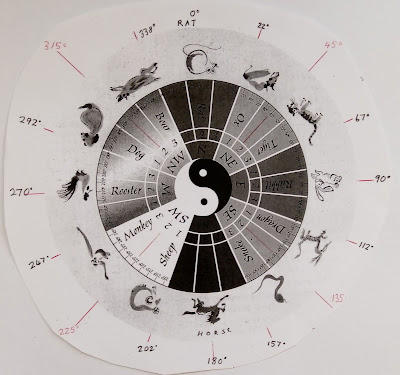- List all the planetary bodies and key axis points you use. N = lunar nodes A =Ascendant-Descendant M =midheaven-IC
- Round up/down the degree positions to nearest whole number
- run a column to the right listing the 15 degree resonating point. for planets at over 15 degrees subtract 15. For under 15 add 15. 15 itself becomes 30/0
- Create another box with degree positions from 0-30/0
- Refer to box one and transfer each entry. Example : Sun is listed at 10 and 25.
- This graphic view allows you not only to see natally which factors are in strong synergy but also very useful with transits to track where the significant action is taking place and the sequential activations. Orbs of effect vary dependent upon speed and "weight" of the factor in transit. A transit one-two degrees off natal exact point is definitely worth noting.
- Every factor and point therefore gets a "double-dose" Example: Moon at 15 and 30/0. So when any exact point is "live" you know that 15 degrees later will be a further resonance activated.
the 15 degree factor comes as a result of dividing the 360 degree wheel into 24 divisions. Therefore this is called the 24th harmonic. semisquare and sesquiquadrate are most commonly known in that group but unwisely overlooked, considered weak. Incorrect in my experience. Hidden yes when nothing else seems to be identified as active. Look and you will find.
The logic behind the 24th and 15 degree divisions comes back to the finer divisions of the circle or wheel: angles 45 135 225 and 315 each sit midway therefore serve as a midpoint of the key angular points at 0 90 180 270 degrees.
Midpoint positions are known to capture the essence from both energies equidistant to that point.
The related drawing shows those 8 points.
The connection with Chinese Divination
Chinese divination uses the 8 compass points from what is to the West an upside down perspective facing the equator and sunrise and the South. The midpoints of the key 4 directions are well known to the world as NW NE SW SE . The Chinese method is to further subdivide each direction into 3 - giving 8x3 = 24 sectors of 15 degrees each. These sectors are called Mountains. Depending upon which "stars" fall into each sector determines good or bad luck for the year. One "star" equates to Jupiter (Tai Sui) - seen as a formidable force which demands respect or disaster will follow. It can be seen how Jupiter can also be adverse in the Western view if proper restraint is not used when excesses get extreme.
This use of 15 degree divisions has an application to the Chinese solar year beginning Feb 4 annually 9at our midpoint of Aquarius -Start of Spring in the Northern hemisphere but the framework is fundamentally based on the 4 fixed points -2 solstices, 2 equinoxes.
The whole year of days is divided by 24 to get periods of 15.2 days ( each division called a "Chi" ) . These represent astronomical points of the Sun's passage along the ecliptic using just 15 degrees of longitude along the horizon -versus the Western blocks of 30 degrees. Using the 15 degree system allows for the very alternating energy of Yin Yang to be identified.
The Yang ON point of activation sits at 15 degrees (matching 15 degree positions in Western zodiac) and the Yin OFF point occurs at the 30/0 degree position.
Which is very interesting in that the Western view reveres the zero degree ingress which the Eastern view sees as Yin - building to peak Yang at 15 degrees.
It is intriguing to look for a blend of these two perspectives or a comprehensive expansion of both. Many dismiss the superstitious aspects of Chinese geomancy and divination but often the issues arise in crude elaborations followed by poor translations that miss the essence.
Recommend: Derek Webster Chinese Astrology high level research











No comments:
Post a Comment